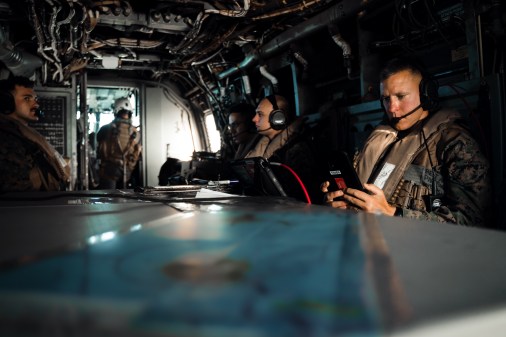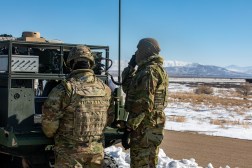Establish integration metrics to prioritize ‘glue’ for all-domain operations

Militaries around the world are struggling with the new reality that battlefield advantage increasingly comes from effectively orchestrating existing munitions, sensors, and troops rather than from game-changing superweapons. Hypersonic missiles didn’t help Russia defeat Ukraine, but Kyiv’s improvised kill chains stopped Moscow’s advance and now have Russian units on the defensive.
The Pentagon’s way of building and buying new gear was not designed for a military that gains an edge by recomposing its pieces like Lego blocks or mosaic tiles. Even recent reforms like the Middle Tier of Acquisition are still designed to create a single product that would later be integrated with other pieces of a kill chain or system-of-systems.
In a fight against China, U.S. commanders will need to synchronize changing combination of systems from multiple domains to succeed. Even if a new weapon or sensor brings extraordinary capabilities, it won’t matter if it is only carried by one type of aircraft or ship and cannot talk to anything else. A peer opponent like the People’s Liberation Army will exploit those limitations to keep the new system out of the fight.
More flexible integration among U.S. forces could give PLA commanders more kill chains to worry about, but is not one of DoD’s strong suits. Previous attempts like the Net-Ready Key Performance Parameter (KPP) and Joint All Domain Command and Control (JADC2) initiative have struggled to deliver tangible interoperability improvements and often become mired in bureaucracy or sidetracked by competing priorities.
However, there are promising signs of a solution. The Undersecretary of Defense for Acquisition and Sustainment’s establishment of a new office for Acquisition, Integration, and Interoperability, or AI2, suggests a recognition that instead of simply buying a new gadget to solve an operational problem, the DoD will increasingly need to buy the “glue” — or software, networks, and engineering — that combines existing systems in novel ways.
Longtime defense watchers know a new office or reorganization plan rarely solves a problem in DoD. For AI2 to succeed it will need to drive changes in how the U.S. military prioritizes interoperability and funds the glue for a more recomposable force. These capabilities often fall outside of a specific service’s lane.
Metrics will be essential to compel needed investments as well as define what constitutes “good enough.” Arguably one of the problems with JADC2 has been its overly-ambitious goals for interoperability, which lead to a top-down approach that has yielded few new effects chains.
Most defense professionals are well acquainted with Technology Readiness Levels, or TRLs, a metric system devised by NASA in the 1970s to assess technology maturity and later adopted by the DoD. TRLs work well for evaluating individual systems, but they do not help assess if a new capability is useful.
The introduction of an Integration Readiness Level (IRL) could address this shortcoming. Where TRLs assess a technology’s maturity in isolation, IRLs would evaluate a component’s readiness for integration into larger, dynamic systems-of-systems. An IRL would consider factors such as the exposure of interfaces and the component’s compatibility with Continuous Integration/Continuous Deployment pipelines used by DoD software factories to integrate new kill chains.
Like TRLs, IRLs could indicate greater degrees for interoperability using a scale from 1 to 9. An IRL of 1-3 suggests a nascent level of integration, where the system generally is used only by the original developer in a narrow set of systems of systems. IRL 4-6 represents a more mature stage, where integration or reuse by third parties is feasible with support from the original developer. The highest levels, IRL 7-9, depict a state where integration is more “plug-and-play,” and can be achieved without the direct involvement of the original developer.
Using the IRL metric could help manage risks associated with system integration and identify opportunities to enhance the modularity and agility of large-scale systems. For instance, the Electro-Optical Targeting System of the F-35 has a high TRL, but its IRL may be low because it cannot talk with other parts of the F-35. Conversely, a new F-35 plugin for the Android Tactical Assault Kit (ATAK) software might have a lower TRL but a high IRL, given its ease of integration across multiple contexts. The opportunity with ATAK would be highlighted by its IRL.
By adopting IRL as a measure, DoD could step away from a narrow focus on individual systems and lay the groundwork for a truly data-centric enterprise. In practice, a new metric will enable joint and OSD leaders to highlight shortfalls, direct appropriate investments by recalcitrant services, and define acceptable levels of interoperability to manage spending in a budget-constrained environment.
IRL, in concert with other strategic initiatives such as the establishment of AI2 and the Chief Digital and AI Office, presents a pathway for the DoD to transform its approach towards technology development and acquisition, pivoting from a focus on standalone systems to a holistic view of integrated capabilities. Unless it makes this shift, the U.S. military could find itself like Russian troops in Ukraine — attempting to use a dwindling supply of silver bullets to stop a learning, adapting force that can incorporate almost anything into a kill chain.
Bryan Clark is a Senior Fellow at the Hudson Institute and Director of the Hudson Center for Defense Concepts and Technology. Dan Patt is a Senior Fellow at the Hudson Institute.






